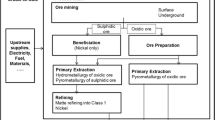Abstract
The overall reduction of the environmental impact by the use of selective catalytic reduction (SCR) of nitrogen oxide emissions in power plants was determined by strict application of ISO 14040 and ISO/DIS 14041. Special emphasis was placed on the implementation of the total product life cycle (PLC) of ammonium molybdate as a key input material. The environmental impact was generated by application of the life cycle assessment (LCA) concept of “ecoscarcity” and integrated in the life cycle inventory analysis (LCI) of SCR systems. The LCI was used to generate the life cycle impact assessment (LC1A) by use of different quantitative valuation methods. Under consideration of the overall LCIA results and the environmental protection costs of the SCR variants, the Ecological Effectiveness of the SCR alternatives was determined. The results enable plausible conclusions with regard to the ecological advantages of the use of deNOx catalysts in the SCR used in hard-coal fired power plants.
Similar content being viewed by others
References
Kalmbach, S.;Schmölling, J. (1990): Technische Anlcitung zur Reinhaltung der Luft. 3., aktualisierte und erweiterte Auflage. Erich Schmidt, Berlin
Siemens AG Power Generation (KWU) (1990): Stickoxid-minderung mit Platten-und Wabenkatalysatoren. Siemens AG, Erlangen
Bárzaga-Castellanos, L.;Neufert, R.;Kayser, G.;Markert, B. (1998): Ökobilanzierung des selektiven katalytischen Reduktionsverfahrens. Gefahrstoffe—Reinhaltung der Luft, 58, pp 313–319
DIN (1997): Environmental management-Life cycle assessment—Principles and framework (German EN ISO 14040 and English ISO 14040 version). Beuth, Berlin
DIN (1997): Environmental management—Life cycle assessment—Goal and scope definition and life cycle inventory analysis (German prEN ISO 14041 and English ISO/DIS 14041 version). Beuth, Berlin
Braunschweig, A.;Müller-Wenk, R. (1993) Ökobilanzen für Unternehmungen—Eine Wegleitung für die Praxis. Paul Haupt, Bern, Stuttgart, Wien
VDI (1995): Kumulierter Energieaufwand, Begriffe, Defini-tionen, Berechnungsmethoden. VDI 4600 Draft. Beuth, Berlin, Düsseldorf
Vigon, B.W.;Tolle, D.A.;Cornaby, B.W.;Latham, H.C.;Harrison, C.L.;Boguski T.L.;Hunt, R.G. (1994): Life-Cycle Assessment, Inventory Guidelines and Principles. Lewis Publishers, Boca Raton, FL, USA
Lindfors, L.G. et al. (1995): Nordic Guidelines on Life-Cycle Assessment. Nordic Council of Ministers, Copenhagen, Denmark
Braunschweig, A.;Förster, R.;Hofstetter, P.;Müller-Wenk, R. (1994): Evaluation und Weiterentwicklung von Bewer-tungsmethoden für Ökobilanzen. Institut für Wirtschaft und Ökologie, St. Gallen, Schweiz
Author information
Authors and Affiliations
Corresponding authors
Rights and permissions
About this article
Cite this article
Bárzaga-Castellanos, L., Neufert, R., Kayser, G. et al. Life cycle assessment of the selective catalytic reduction process for power plants. Int. J. LCA 4, 329–339 (1999). https://doi.org/10.1007/BF02978523
Received:
Accepted:
Issue Date:
DOI: https://doi.org/10.1007/BF02978523




